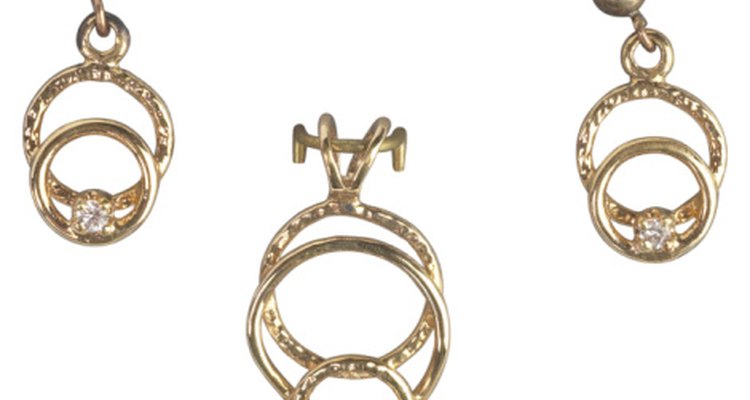
Nipple piercings, once the practice of a small subculture, have become quite commonplace. Professional piercers learn to pierce nipples early in their training. This frequently requested modification can be performed on almost all women and many men, depending on individual anatomy. Although it may be tempting to change your body jewelry soon after receiving your piercing, you must allow sufficient healing time.
Nipple Piercing Procedure
When performing a nipple piercing, the piercer first cleans the areola and surrounding skin with surgical scrub or iodine. She makes a small mark on either side of the nipple to indicate the entry and exit holes for the needle. Marking is usually the most time-consuming part of getting a piercing. When she is satisfied that the marks are even, the piercer will have you lie back on a table like the one in your doctor's office. She will pinch the nipple gently between a pair of forceps, lubricate a hollow single-use needle and have you take a deep breath, pushing the needle through as you exhale. Because the needle is hollow, your nipple ring slips into the end. As the needle comes out, the jewelry goes in. Most people do not even feel the jewelry being inserted.
Aftercare and Healing Time
Small nipples can heal in as little as two months, while larger ones often take up to six. Diligent aftercare is the key to healing any piercing. The Association of Professional Piercers recommends doing warm saline soaks once or twice a day with a mixture of 1 tsp. of non-iodized sea salt to 1 cup of warm bottled water. After soaking for five to 10 minutes, the piercing should be washed with antimicrobial soap and dried with a clean paper towel. Taking Vitamin C and zinc supplements may help speed healing time.
Possible Complications
A piercing is a puncture wound, which leaves the skin open to transmission of bacterial infection. During healing, you must take care not to touch your jewelry without first washing your hands with antimicrobial or antibacterial soap. Products such as rubbing alcohol, hydrogen peroxide and iodine are too harsh for punctured skin and can actually prolong healing time. Some irritation and swelling is normal, especially when your piercing comes in contact with clothing. Infection is indicated by pus leaking from the entry or exit holes. If you suspect a piercing is infected, do not remove the jewelry, as the holes could close and trap the infection inside. When in doubt, visit your piercer or physician.
Recommended Jewelry
Captive bead rings are the jewelry most often used in initial nipple piercings, as a ring can move freely through a swollen nipple. When the piercing is healed, some people choose to insert snug-fitting barbells, which give the appearance of a small bead on either side of the nipple. Circular barbells are popular as well. These are rings bent into a horseshoe shape, with beads that unscrew on both ends. Common metals for nipple jewelry are surgical steel, titanium and niobium. Gold and platinum are appropriate as well.
Changing Body Jewelry
Captive bead rings can be the trickiest pieces of body jewelry to change, especially at larger gauges, or thicknesses. A captive ring exerts pressure between its two prongs to hold a bead in place. Rings above a 14 gauge often require ring-opening pliers to get the bead in and out. The beads on the ends of barbells can be unscrewed, making them relatively easy to change without a piercer's help. Always look for internally threaded jewelry, in which male beads screw into a female bar. The threads on externally threaded jewelry can damage the tissue inside a piercing when inserted. Lubricating your jewelry with a water-based lubricant will make it easier and more comfortable to insert.
Related Articles

How Long Do I Have to Wait to Change My ...

How Long to Wait Before You Change a ...

How to Gauge the Ears Right After the ...
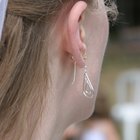
How to Open Pierced Ears That Have ...
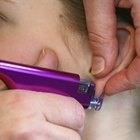
What Size Gauge Is an Ear Piercing Gun?
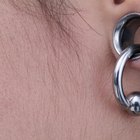
Ear Gauge Problems

How Long Before a Nose Ring Hole Closes?
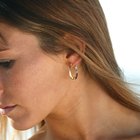
How Long After Piercing Can You Wear ...

How to Change a Labret
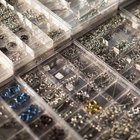
Complications of Nipple Piercing

How to Put in a Captive Bead Lip Ring

How to Remove a Captive Navel Ring

How to Remove a Labret Piercing

How to Remove Your Nose Piercing & Put ...
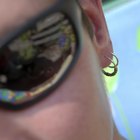
Places to Pierce Your Ear
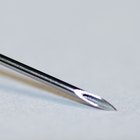
Types of Piercing Needles

What to Do When a Nose Ring Falls Out

How Do They Pierce Your Ears With ...

What Is Bio-Flex Made of for Piercings?

Facts on Nose Piercings
Writer Bio
Ann Jones has been writing since 1998. Her short stories have been published in several anthologies. Her journalistic work can be found in major magazines and newspapers. She has a Master of Fine Arts in creative writing.
Photo Credits
Hemera Technologies/PhotoObjects.net/Getty Images